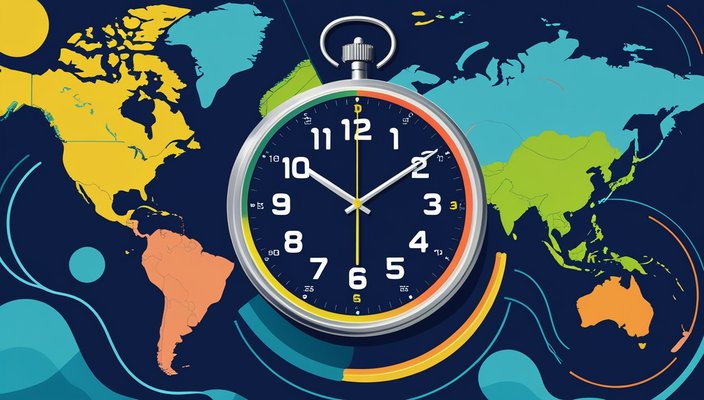
Let me tell you something: if you've ever frantically googled "what time is it in Tokyo right now" at 2 AM, you're not alone. I've been there more times than I care to admit. Whether you're trying to catch your colleague in Mumbai before their day ends, or you're a freelancer juggling clients from San Francisco to Sydney, getting time zones right can feel like solving a puzzle while blindfolded.
I've been that person who showed up to a Zoom call an hour early because I messed up the time zones. After years of working with teams across three continents, I've learned that a good time zone converter isn't just helpful—it's absolutely essential for your sanity.
After countless scheduling mishaps (and one particularly embarrassing incident where I woke up my German client at 3 AM), I've become something of a time zone convert—pun intended. Here's everything I wish someone had told me about using time zone converters properly in 2025.
The Basics of Time Zone Conversion (Without the Boring Geography Lesson)
Okay, so technically the world has 24 time zones—one for every 15 degrees if you want to get all mathematical about it. But here's the thing: countries do whatever they want. China decided to use just one time zone for the entire country. Can you imagine? Meanwhile, Russia spans 11 time zones, and don't even get me started on the mess that is Australia with their half-hour offsets.
The one thing you need to know is UTC—Coordinated Universal Time. Think of it as the "master clock" that everyone else measures against. When you see EST (UTC-5) or JST (UTC+9), those numbers tell you how many hours that place is ahead or behind UTC. Once you get this, everything else starts making sense. Need to convert UTC to EST quickly? Our converter handles this automatically.
Best Time Zone Converter Tools in 2025
I've tried dozens of time zone converter tools over the years—from the basic Google search (which works in a pinch) to fancy apps that cost more than my monthly coffee budget. Here's what separates the good ones from the ones that'll leave you confused:
Essential Features for Time Zone Converters
Real-Time Accuracy
The most accurate time zone converters sync with atomic clocks. When you're dealing with time-sensitive stuff, every second counts. Our time zone converter updates in real-time to ensure precision.
Automatic DST Handling
DST is the bane of my existence. The best time zone converters handle all daylight saving transitions automatically, including the tricky transition periods between US and European DST changes.
Multi-Zone Display
When coordinating between New York, London, and Singapore, you need converters that show all zones simultaneously. No more switching back and forth between different cities.
Future Date Support
Planning meetings weeks in advance? The best time zone converter tools account for future DST changes, ensuring your scheduled meetings stay accurate.
Ready to test these features? Try our free time zone converter that includes all these essential capabilities and more.
Free vs Paid Time Zone Converters
Here's the honest truth about free time zone converters vs paid options: for most people, free tools are more than sufficient. The key differences usually come down to convenience features rather than accuracy.
Free Time Zone Converters
Pros: Just as accurate as paid versions, perfect for occasional use, no subscription hassles, web-based accessibility.
Best for: Freelancers, small teams, occasional international calls.
Our free time zone converter offers enterprise-level accuracy without any cost.
Paid Time Zone Converters
Pros: Advanced scheduling features, team collaboration tools, calendar integrations, offline functionality, custom branding options.
Best for: Large teams, frequent travelers, businesses with complex scheduling needs.
How to Convert Time Zones Accurately (Step by Step)
Here's my foolproof method for accurate time zone conversion that's saved me from countless scheduling disasters:
Step 1: Verify Your Current Location
Always double-check which time zone you're currently in. When traveling or working remotely, it's easy to forget your actual location. Most reliable time zone converters will auto-detect this, but manual verification prevents errors.
Step 2: Select Specific Cities
Don't just pick any city in the time zone—be specific. If you're scheduling with someone in Mumbai, use Mumbai rather than just "India Standard Time." This ensures you're accounting for any local variations or rules.
Step 3: Include Complete Time Details
Always specify AM/PM for 12-hour format and include the full date for future meetings. For common conversions like EST to PST, bookmark the specific converter page for instant access.
Step 4: Cross-Reference Important Meetings
For critical meetings, verify the time using a second converter. This 30-second check has saved me from embarrassment countless times. I recommend keeping multiple reliable time zone converters bookmarked.
Pro Tips for Perfect Time Zone Conversion
Master the Visual Approach
Keep a world time zone map bookmarked because sometimes you need the big picture. When it's 9 AM in New York, it's already evening in most of Europe. Visual references help you understand global time relationships better.
Bookmark Your Common Conversions
For frequently needed conversions, create direct bookmarks: IST to EST converter for India-US meetings, CET to PST converter for Europe-West Coast calls, and IST to GST converter for India-Gulf coordination.
Find Your Golden Hours
If you regularly work with international teams, identify overlap hours and stick to them. My US-Asia team learned that 8 AM Pacific / 11 PM Singapore time works for everyone.
Leverage Calendar Intelligence
Google Calendar automatically converts meeting times for different attendees. When you send a meeting invite for "2 PM EST," it shows up as "7 PM GMT" for London colleagues automatically.
Common Time Zone Conversion Mistakes to Avoid
Learn From These Common Errors
DST Transition Confusion: Europe and North America switch to daylight saving time on different dates. There's about a month in spring and fall where time differences are unusual. The best time zone converters handle these transitions automatically.
EST vs EDT Confusion: Eastern Standard Time (EST) is winter time. Eastern Daylight Time (EDT) is summer time. When someone says "EST" in July, they probably mean EDT. Always clarify or use converters that handle this automatically.
The Arizona Exception: Most of Arizona doesn't observe daylight saving time. This creates unique conversion challenges that only accurate time zone converters can handle properly.
Time Zone Converter Tools That Actually Work
Web-Based Solutions: For instant access without downloads, bookmark these reliable converters. Whether you need to convert UTC to EST for US coordination or handle IST to GST conversions for Gulf region meetings, having direct links saves valuable time.
Browser Extensions: Time Zone Converter extensions automatically highlight times on web pages and show local conversions. Super handy when reading international event announcements or scheduling across multiple sites.
Mobile Apps: World Clock Pro (iOS) and TimeZone Converter (Android) offer offline functionality—crucial when traveling. These apps sync with your calendar and send meeting reminders in your local time.
Built-in Platform Features: Don't overlook existing tools. Slack shows everyone's local time, Microsoft Teams handles time zone conversion in meeting invites, and Google Calendar is intelligent about international scheduling.
Frequently Asked Questions About Time Zone Converters
What time zone converter is most accurate?
The most accurate time zone converters sync with atomic clocks and automatically handle DST transitions. Our time zone converter uses official time standards and updates in real-time for maximum precision.
How do I convert time zones for future dates?
When converting times for future meetings, use converters that account for upcoming DST changes. Simply input the future date along with the time, and reliable converters will automatically apply any seasonal adjustments.
Which time zone converter works best for business meetings?
For business use, choose converters that show multiple time zones simultaneously, handle DST automatically, and integrate with calendar applications. Features like EST to PST conversion or CET to PST conversion should be easily accessible.
Are free time zone converters reliable?
Yes, free time zone converters can be just as accurate as paid versions. The key is choosing ones that sync with official time standards and handle DST transitions properly. Most business users find free converters perfectly adequate for their needs.
Master Time Zone Conversion in 2025
Dealing with time zones will never be fun, but it doesn't have to be the source of constant stress it once was. The key to accurate time zone conversion is finding reliable tools and using them consistently.
My system involves keeping multiple time zone converters bookmarked, setting up phone clocks for key cities, and always double-checking important meeting times. It takes an extra minute but saves hours of confusion.
The tools keep improving, and most of the best time zone converter options are completely free. Try several options, find what works for your workflow, and use it consistently. Your international colleagues (and your sanity) will thank you.
Start Converting Time Zones
Stop second-guessing meeting times and start converting with confidence. Our comprehensive time zone converter handles all the complexities.
SEO Specialist, Digital Marketing Expert
Lukesh Pillai is a seasoned SEO specialist and digital marketing expert with over five years of experience in the industry. His expertise spans search engine optimization, content strategy, and …


